Click on images to enlarge
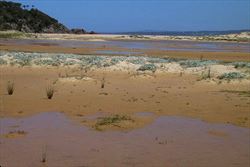
infestation (Photo: Jackie Miles and Max Campbell)

habit (Photo: Jackie Miles and Max Campbell)
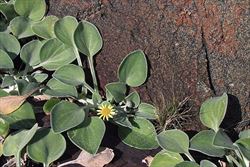
habit (Photo: Jackie Miles and Max Campbell)
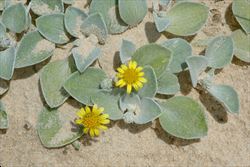
leaves and flower-heads (Photo: Rob and Fiona Richardson)
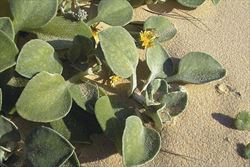
leaves (Photo: Jackie Miles and Max Campbell)
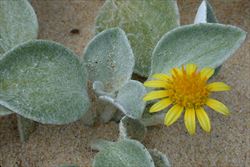
leaves and flower-head (Photo: Rob and Fiona Richardson)
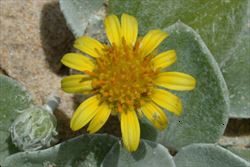
close-up of flower bud and flower-head (Photo: Rob and Fiona Richardson)
Scientific Name
Arctotheca populifolia (P.J. Bergius) Norl.
Synonyms
Cryptostemma niveum (L. f.) NicholsonArctotheca nivea (L.f.) Lewin
Family
Asteraceae (Queensland, New South Wales, the ACT, Victoria, Tasmania, Western Australia and the Northern Territory)Compositae (South Australia)
Common Names
beach daisy, beach pumpkin, Cape beach daisy, coast capeweed, dune arctotheca, South African beach daisy
Origin
Native to the southern African coastline, from the western coast of South Africa to the southern coast of Mozambique. In its native habitat it grows in deep sand on coastal dunes and around estuaries.
Naturalised Distribution
Beach daisy (Arctotheca populifolia) is widely naturalised in the coastal districts of southern Australia (i.e. in the coastal districts of New South Wales, Victoria, Tasmania, some parts of South Australia, and the southern and western parts of Western Australia).
Notes
This species is regarded as an environmental weed or potential environmental weed in parts of Western Australia, South Australia, Tasmania, Victoria and New South Wales. It is a pioneer of beach sand and foredunes that is capable of rapid regeneration in extreme conditions. It is of concern throughout the temperate regions of Australia, where it can be highly invasive and cover large areas of accumulating sand. Beach daisy (Arctotheca populifolia) is also known to invade grasslands on basalt soils.
On the south-east coast of New South Wales beach daisy (Arctotheca populifolia) competes with and replaces native beach and dune vegetation, such as spinifex grass (Spinifex sericeus). It is also more strongly sand-binding than the natives it usually replaces, resulting in sand dunes becoming steeper and the structure of the entrances of coastal lakes being affected (e.g. it has trapped sand at the mouth of Wallagoot Lake on the far south coast of New South Wales). Such changes in beach and estuary landforms may also threaten the nesting habitat of shorebirds and affect public use of these areas.
On Flinders Island, north of Tasmania, beach daisy (Arctotheca populifolia) is becoming established in unconsolidated sands and also grows between the sand ridges in dune systems and on beaches. It is in the early stages of establishment in this state and is one of five potentially significant beach weeds that have been suggested as eradication targets. In South Australia, beach daisy (Arctotheca populifolia) is a common weed in the Gulf St. Vincent area (i.e. near Adelaide) and is scattered on the Eyre Peninsula, the Yorke Peninsula and along the South East coast. It has also been recorded in conservation areas in this state (e.g. in Coorong National Park). In Western Australia it grows on foredunes from Perth to Esperance and is listed as a moderately important species in the state's environmental weed strategy. In the City of Joondalup, near Fremantle, it is regarded as a high priority environmental weed species in coastal foreshore natural areas.

